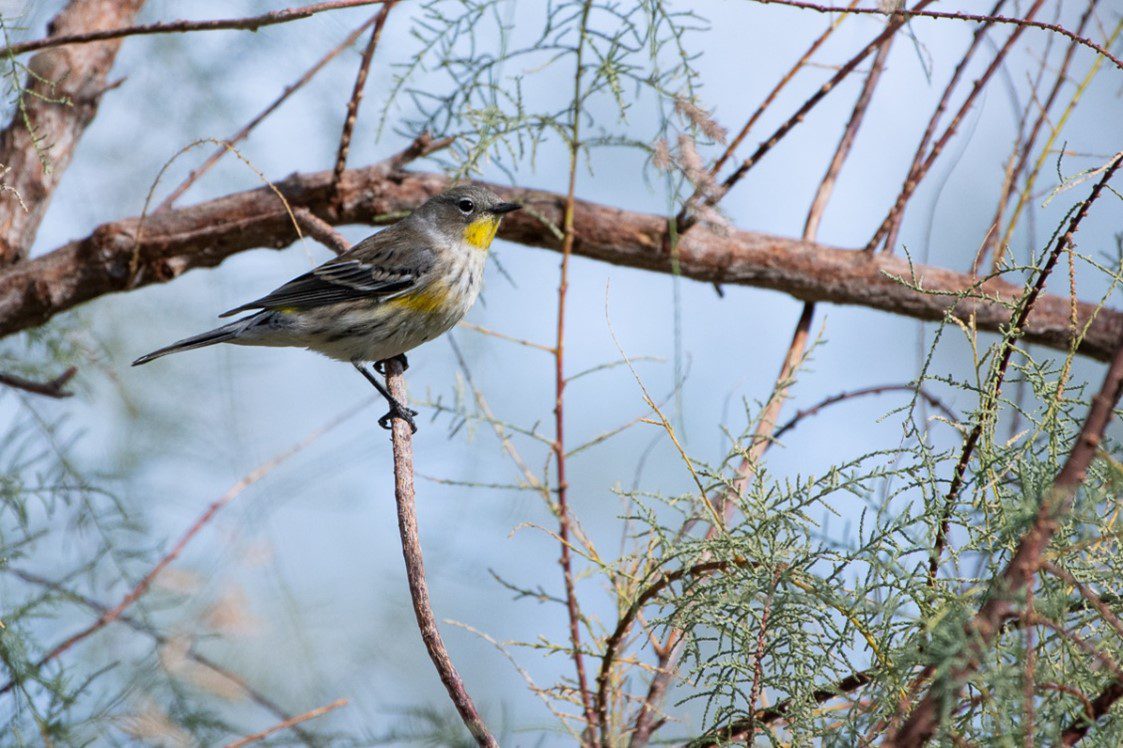The Yellow-rumped Warbler

“BUTTER BUTT?” Oh, YES!
Yellow-rumped warblers (Dendroica coronata) are common and plentiful spring and fall migrants through Clark County Wetlands Park. Birders have given this species the nickname “Butter Butt” because in addition to its yellow throat and side markings, it sports a distinctive and often conspicuous bright yellow rump patch. Alas, we cannot see our model’s “butter-butt” because of his “side-on” photo pose.
The common name “warbler” comes from the Old French word “werbler,” meaning “to sing in trills.” Humans like the sound of warblers singing, but it is much more important than just a pretty sound to the birds. Warbler females actually choose their mates based largely on the song quality of the males singing around them.
The yellow-rumped warbler is the most common of the 50 North American warbler species and is found across the United States and Canada where migrating flocks are often seen. These birds nest in more open coniferous forests and their edges, and winter in open, brushy habitats like willow thickets and field edges.
On the summer menu for these small, fast-moving, actively foraging songbirds is a wide variety of insects, including juicy caterpillars, crunchy beetles, tangy ants, aphids, grasshoppers, and even spiders. Yellow-rumped warblers often perch upright on a relatively exposed perch and fly up to catch their meals. They may also skim like swallows over ponds, eating insects from the surface. They are even known to snatch insects right out of webs and under the very noses of spiders, who are better off not to object to the theft!
Yellow-rumped warblers have a unique adaptation for winter feeding. They produce high levels of bile salts in their digestive tracts that enable them to digest the waxy coatings of berries like juniper, bayberry, wax myrtle, and even poison ivy. With this menu, they are able to winter further north than other kinds of warblers. They also favor grapes and are not shy about visiting bird feeders for the suet and fruit placed there by bird watching enthusiasts.
The yellow-rumped warbler species was created in 1973 when taxonomists combined two previously- recognized species, the myrtle warbler (northern and eastern United States), and Audubon’s warbler (western United States) because the two species look similar and can hybridize with each other. New genetic tests may, however, justify a future “re-split” of these two species, as well as revisions for other species that range southward into Mexico. Warbler enthusiasts, stay tuned.
Ornithologist David Allen Sibley in his book, “What it’s like to be a Bird,” suggests considering a few points about bird migration as we watch for migrating yellow-rumped warblers (and other birds): first, note that migration “days off” are very risky times for migrating birds. Just imagine, he says, flying all night and landing in an unfamiliar place at dawn. “Where is water? Food? Shelter? How can you avoid predators?” Second, Sibley points out that even small urban parks and residential yards can be magnets and havens for migrant birds. For a bird-friendly yard, he suggests planting native plants (they attract more local insects than “imported” landscape plants). Add a water source and avoid using pesticides – Sibley notes the birds will handle the bugs for you.
When you are on the hunt for migrant birds along Clark County Wetlands Park trails, binoculars definitely help. Plan to spend some time, and patience, looking for fast-moving, never-still-for long species like warblers. Watching is fascinating but be careful to avoid what birders sometimes call “warbler neck,” an overuse injury caused by holding a 90-degree neck angle for too long while scanning treetops and large bushes for the birds overhead!
-By Chris Leavitt, President; photo by David Walker
Please enjoy these YouTube videos:
Yellow-rumped Warbler McElroy Productions 2:28
Yellow-rumped Warbler (“Butterbutt”) Warbler Ridge Birds 2:35
Yellow-rumped Warbler feeding on Juniper berries Stoil Ivanov 1:14
Yellow-rumped Warblers Devouring Suet Z Nighthawk 0:43
